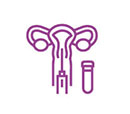BLASTOCYST CULTURE
Embryo at Day 5 from the day the male gamete(sperms) and female gamete(oocyte) are fused in-vitro (taken as Day 0) is referred to as a blastocyst. Blastocyst have a central, fluid-filled cavity(blastocoel) and two distinct cell types, namely, inner cell mass and trophectoderm. The trophectoderm later forms the placenta while the inner cell mass forms the fetus.
Therefore, growing the embryos from Day 0 to Day 5 in a culture media mimicking the changing environment of the reproductive tract in order to meet the specific requirement of the embryo as it travels down the fallopian tube to the uterus is called Blastocyst culture.
Advantages of Blastocyst transfer
- Helps identify the embryos with limited as well as high developmental ability with the help of their morphological assessment and grading
- The survival rate of embryo after freezing and thawing is par excellence
- High implantation (ability to attach to the uterus) has been reported with blastocyst transfer, further reducing the number of embryos to be transferred
- As the uterine environment is exposed to the effect of hormonal drugs (exogenous gonadotropins) used for stimulation of the ovaries during IVF, therefore blastocyst transfer helps minimize the exposure of embryo to such an environment
- Cleavage-stage embryo (Day 3 embryo) biopsy for PGT can be done without the need for cryopreservation when the biopsied cells(blastomeres) need to be sent to a distant location for analysis
- Trophectoderm biopsy can also be done rather than cleavage-stage biopsy, hence increasing the number of cells (6-10) that can be analyzed
- Finally, it increases the overall efficiency of IVF
- Increased pregnancy outcome
- Makes the process of PGT more efficient
- Improved embryo survival after freezing and thawing
Blastocyst formation rate (Success rate)
Under standard IVF condition, 40% to 60% of embryos progress to blastocyst stage after 5-day culture and they also have a high implantation potential as compared to cleavage-stage embryos (Day 3 embryos).
Frequently asked questions
Q1. Why are embryos not cultured in the laboratory beyond Day 5?
Ans:- In a natural cycle embryo grows for 2 days in the fallopian tube (Day 0 to Day 2) and then progresses towards the uterus where, it starts to embed below the surface of endometrium around Day 5. Therefore, this is the reason why it is not advised and preferred to culture embryos beyond day 5 in the laboratory in an IVF cycle as it cannot delay the process of embedding in the uterus.
Q2. ) Why is blastocyst culture so successful?
Ans:- The synchrony between the development of the embryo and the lining of the womb increases the chances of implantation as blastocyst transfer mimics natural conception in which the embryo travels down the fallopian tube and reaches the uterine cavity five days after fertilisation.
Q3. Does it cost extra to culture embryos to blastocyst stage?
Ans:- No TESA is not at all painful as local anaesthesia or sedation is used. Only some discomfort may be there.
Q4. What is the success rate of blastocyst transfer?
Ans:- The implantation potential of a blastocyst is around 80% in our centre

